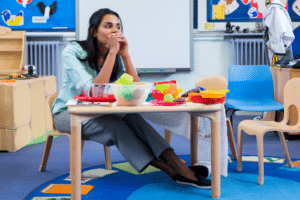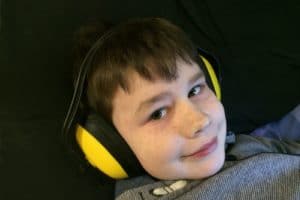We are two years into the COVID-19 pandemic. This is a time of complex and collective trauma. Collective traumas are cataclysmic; complex traumas are long-term and many layered, affecting many areas of our lives. These two years are no exception, impacting every area of our lives. For teachers in particular, the pandemic has drastically altered the fabric of daily life within and outside of schools. It comes in the midst of other major disruptions—budget cuts, increasing pressures around state testing, school-based violence, and larger economic and social issues impacting how teachers are allowed to engage in the classroom.
These same issues are impacting students, parents, colleagues, and administrators. Many schools are reporting sharp increases in mental health and behavior crises alongside sharp decreases in engagement. What can help teachers manage these concerns while also caring for their own needs during this collective challenge? Through this series of blogs, we hope to provide some ideas and tools to support you, including concrete, actionable steps as well as alternate ideas or perspectives. And we are going to start in what may seem like an unusual place: with the power of attachment.
What is attachment and why does it matter?
Attachment, at its most basic, is a “deep and enduring emotional bond (Ainsworth, 1973)” with another person and it starts with our earliest caregivers. This bond becomes a foundation for how we view our self, our relationships, and the world in which live. The degree of safety, warmth, and trust in this bond is carried forward into every aspect of our being, with significant impacts on our emotional wellbeing, future relationships, cognitive functioning, and general psychological state. Basically, our attachment styles are critical to who we are.
So, what happens when that bond isn’t built on security and trust? Well, we learn ways of behaving, managing emotions, and relating to people that are ineffective in meeting our most basic emotional and relational needs. Maybe, to protect against rejection and pain, a child learns to push others away, mask vulnerabilities, and keep up their walls (Dismissive/Avoidant). Maybe, they cling on to people, become overly dependent, or are preoccupied with caring for others because then they won’t be abandoned (Preoccupied/Ambivalent). Some children may even end up with a mix of the two, pulling people closer and pushing them away at the same time (Disorganized).
Insecure attachment has other impacts. We can also struggle to notice our own thoughts and feelings (self-awareness) and be able to think about and change them (self-regulation). These are skills that help us succeed in school and later in our careers—they help us learn how to learn, to be curious about information and perspectives, and to believe we have agency to change our thoughts, feelings, and behaviors.
The idea that not having a secure bond in our early life can have such wide-ranging impacts on a person can seem pretty limiting. We cannot change the past—our own or our students’. And a child is only in our classroom for a year or two. In the current situation, you may not even have a child physically in your presence at all, and many things that used to be possible—hugs and shoulder squeezes, showing a bright and welcoming smile, being in close proximity when we talk about difficult things—are limited by the necessities of masking and social distancing during this pandemic.
How can this knowledge help us, as teachers?
While parents and early caregivers are pivotal in children’s lives, they are not the only adults children bond with! It’s likely that as you read this, you can think of key figures in your own life who shaped your beliefs about yourself, others, and relationships, and shaped how you learn, reflect, and relate with other people. I would even go so far as to say it’s likely at least one of those people was a teacher! Have you ever thought about something and been able to just know what an old teacher or mentor would say about it? That’s because you internalized that person and the special relationship you shared with them.
This doesn’t mean that as a teacher you are somehow responsible for your student’s attachment. Indeed, students leave every year, and most bonds aren’t enduring. And that’s ok too. This does mean that the relationship between you and your students can be healing. The adults and peers within a school are powerful figures in a child’s life. Children’s brains are neuroplastic and constantly developing new neural pathways as they have new experiences. As a teacher, you are a consistent presence for each child, and you have the power to start and strengthen secure/trusting paths.
As such, you can use different aspects of your classroom to help this happen. Your management of the classroom can foster trusting relationships with peers that reinforce those secure pathways. By acting as a safe haven in this way, you help kids feel safe and supported in dealing with difficult academic and social situations. Your support, encouragement, and consistency make you a secure base that allows your students to really try new things, take on learning challenges, and master new material. Remember, the attachment you develop throughout the year can impact student’s long-term success. And while your day-to-day relationship will end, there is a security in knowing that when relationships end, what we learned can remain.
So, what do I even do with this?
We are all in the middle of a complex, collective trauma, and while that collective aspect makes things more complicated, it also means we are in it with each other. And it means that how we go about being with each other during this time really matters. The thing is, there’s nothing teachers can be doing that isn’t already something you probably do every day, but it can help to think about how we might be really intentional about it. Here are a few concrete suggestions for how to use an awareness of attachment to support your students and yourself:
- Make consistency key in your classroom and daily interactions i.e. teaching explicit expectations for behavior in different activities and settings and making consequences clear long before problems happen.
- Use tools like CHAMPS (the Conversation, Help, Activity, Movement, Participation, and Success model for providing clear expectations) and posting 3-5 specific rules in the classroom to help make expectations explicit. For many students, rules are best phrased as what they are expected TO DO rather than what NOT to do.
- Praise should be specific, descriptive, and include why the behavior is important, if possible. “I appreciate that you waited with your hand raised quietly until I could help you. It helped everyone hear the directions without being distracted. Thank you.”
- Be thoughtful and intentional about how kids enter and leave your classroom. Having a regular routine that happens the same way every day goes a long way to helping students—and ourselves—stay regulated.
- Warm, positive interactions should be far more frequent than interactions that are negative in tone or content. A good rule of thumb can be at least 7 positive interactions to every 1 negative interaction. Be intentional about noticing what the balance of positive and negative interactions is with both your class as a whole and individual students/parents.
- If you notice you aren’t having as many positive interactions as you would like, try putting a few rubber bands on your wrist or paperclips in your pocket. For each positive interaction you have with your target (a specific child, the class, or even a coworker), move a band or clip to the other wrist/pocket. Aim to move all your items from one side to the other every hour.
- Students tend to do better academically and behaviorally when we communicate that we have a positive opinion of them and feel warmly toward them. For example:
- Students feel more engaged and positive when teachers have high but realistic expectations of their behavior and academic success. This includes calling on students in class and granting autonomy when possible (e.g., allowing them to complete work their own way and letting them choose between options you offer).
- Students recognize when we have prepared for our time with them and respond more when their teacher appears to care rather than question whether the information was presented in an interesting or engaging way.
- Students respond positively with teachers who notice their needs and help meet them, including things like noticing when kids need a break, being responsive to bathroom and water breaks, and noticing when a student needs help. Even just verbally acknowledging a need for assistance (“Jenny, I see you need me; I need to finish X then I will be right there”) helps kids stay engaged and manage their own frustrations.
- Actively practice shifting the lens used to understand behavior. When a child, parent, or colleague makes a poor choice, or when you are feeling frustrated with yourself, ask “what happened to cause this” rather than “what is wrong with you/me.” A compassionate and situation-focused lens can help us remain calm and responsive when problems occur.
- When correction is needed, especially due to misbehavior or conflict with a student, parent, or colleague, it’s important to notice your own emotional state first and take steps to care for yourself before engaging. Communication that is calm, direct, and firm will help the other person be calm and regulated enough to hear what you need to say and respond appropriately.
- As a teacher, you can function as both a secure base and a safe haven as students engage in learning—a process with inherent risks as they will inevitably make mistakes. Encourage and support students as they make every step—no matter how small it seems—towards trying things on their own. Be intentional about empathizing with how difficult it is when we are afraid to try or when we fail. And communicate that you believe in their success.










